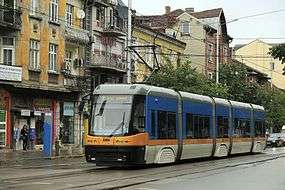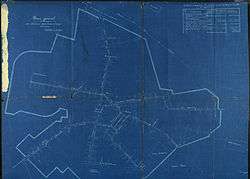Trams in Sofia
 | |
| Operation | |
|---|---|
| Locale | Sofia, Bulgaria |
| Open | 1 January 1901 |
| Status | In operation |
| Lines | 14[1] |
| Owner(s) | Capital (Sofia) municipality |
| Operator(s) | Sofia Public Electrical Transport Company JSC |
| Infrastructure | |
| Track gauge |
1,009 mm (3 ft 3 23⁄32 in) and 1,435 mm (4 ft 8 1⁄2 in)[2] |
| Stock | 176[2] |
| Statistics | |
| Track length (single) | 308 km (191 mi)[2] |
| Route length | ~154 km (96 mi) |
| Stops | 165[1] |
The Sofia tram network is a main public transportation facility in Sofia, the capital of Bulgaria. It began operation on January 1, 1901.[2] As of 2006, the tram system included approximately 308 kilometres (191 miles)[2] of narrow and standard gauge one-way track.[2] Most of the track is narrow gauge (1,009 mm (3 ft 3 23⁄32 in)), with standard gauge (1,435 mm (4 ft 8 1⁄2 in)) used on lines 20, 22 and 23 and accounting for approximately 40 kilometres (25 mi) of the system's track length.[2]
History
On 1 December 1898 the capital municipality gave concessions for building tram lines to French and Belgian companies. Construction took place for a little more than a year and the first tram line was inaugurated on 1 January 1901. Initially the population was served by 25 motor cars and 10 trailers which covered six lines with total length of 23 kilometres (14 mi) and gauge of 1,000 mm (3 ft 3 3⁄8 in) metre gauge.[2]

In the period between 1901 and 1931 large numbers of motor cars and trailers were purchased from different European manufacturers. In 1931 Bulgaria started building their own carriages under the supervision of the engineer Teodosiy Kardalev. These were known as Kardalev's carriages. In 1936 the first Bulgarian motor cars were produced under the brand DTO (Дирекция на трамваите и осветлението - Direktsia na tramvaite i osvetlenieto: Department for trams and lighting, owned by Sofia municipality). Initially old frames were used for the production.[3]
In 1934 the first large tram depot was built in the Krasno selo district. In 1951 there was constructed a factory to build newer model tram cars. This tram manufacturer (known as Трамваен завод - Tramvaen zavod: Tram plant) was named "Трамкар" (Tramkar: Tram car) in 1990 and was a registered company Tramkar till 2008. Through 1959 it produced 155 DTO and Republika motors, which were the first fully Bulgarian-built trams. The last tram, T8M-900 was delivered in 1991 and is still in use.[2] Since then the factory has been used to repair and renovate old trams.
In 2017 the network was complemented with 28 second-hand Be 4/6 S "gherkin" trams partly donated from the BVB section of the tram network of Basel. The trams were constructed in 1990-91 and had low-floor sections inserted in their centre in 1997-99. They replaced older vehicles on lines 6, 8 and 12.
Sofia's first standard gauge tram line was opened in 1987. Until that time all lines were nominally metre gauge, but actually constructed to a width of 1,009 mm (3 ft 3 23⁄32 in). Eight years later, in 1995, the second standard gauge line was finished. No other tram lines have been built since then, as Sofia has focused its efforts on the construction of its metro system.[2]
Tram lines

See also
- List of tram and light rail transit systems
- Sofia Metro
- Sofia Public Transport
- Trolleybuses in Sofia
References
- 1 2 "Route network of tram lines of Sofia's public transportation" (PDF). Sofia Urban Mobility Center. 2013. Retrieved 2013-09-10.
- 1 2 3 4 5 6 7 8 9 10 "Urban transport - History of Sofia Trams". Sofia Urban Mobility Center. 2013. Retrieved 2013-09-10.
- ↑ History of the Sofia tram, Georgi Aleksandrov, retrieved on 2009-10-04.
External links
| Wikimedia Commons has media related to Trams in Sofia. |
